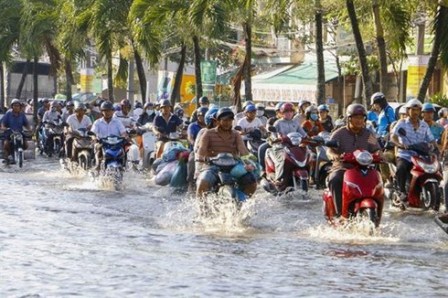High tides, dykes and land subsidence are causing serious flooding in urban areas in the Cuu Long (Mekong) Delta region, according to Nguyen Huu Thien, an expert on the Delta’s ecosystem.

High tides cause flooding on Mau Than Street in Can Tho city
Thien told Thanh Nien (Young People) newspaper that excessive exploitation of groundwater had contributed to severe subsidence in the Delta.
More than one million wells have been dug since the 1980s, and many dykes have been built along most of the Delta's rivers and canals.
“A huge amount of water cannot be discharged to fields or ponds. As a result, flooding occurs in urban areas,” Thien said.
Research by Utrecht University in the Netherlands published in 2017 showed that the average land subsidence rate in the Mekong Delta is 1.1cm every 12 months. In some places, it has reached 2.5cm per year.
By 2050, the land subsidence rate is expected to reach 35-140cm per year, while the sea level could rise 10cm per year.
With the speed of subsidence higher than the pace of rising sea levels, severe flooding could occur.
Le Anh Tuan, deputy director of the Research Institute for Climate Change at Can Tho University, said the water level on the Hau River in Can Tho city was 2.25m on September 30, higher than the peak tide of 2.23m recorded last year.
This is the highest level in the past few decades.
Only a number of new and upgraded streets are 2.3-2.5m high, a level that can prevent flooding. The height of old streets are from 1.6-2m, lower than flood levels, he said.
Most streets in the centre of Can Tho were covered with up to 0.5-0.6m of water.
Ngo Thi Thanh Truc, a resident in Mau Than street in the city’s Ninh Kieu district, said the floods had affected her businesses and family life.
“In recent years, I had to close my business due to serious floods,” she said.
On October 1, a 50-year old woman died after falling into Bun Xang Lake in Can Tho city’s Ninh Kieu district.
The accident occurred at around 6.30pm while the woman was riding her motorbike on the road along the lake.
The women could not distinguish between the water in the lake and the floods, passersby said. People in the area tried to save her but it was too late because of the deep water.
Urban areas in An Giang, Vinh Long, Soc Trang and Hau Giang provinces are also facing the same situation.
“Solutions are needed to mitigate the losses,” Tuan said.
Hoang Minh Tuyen from the Ministry of Natural Resources and Environment’s Department of Water Resource Management said the water flowing down from the upstream region had not caused flooding across the delta region. The water levels measured on the upstream of the dams were still low, he said.
On October 2, the water levels were 3.51m at Tha La Dam and 3.5m at Tra Sư Dam.
“Climate change and rising sea levels are the causes of the unusually high tides,” he said.
Tidal peaks are much higher than the average levels in previous years, often by 15-16cm.
Nguyen Van Thanh, head of the Vietnam Road Administration’s Road Management Department No.4, said there were 31 flood-prone sites on seven national highways. The department plans to upgrade these areas based on results of a survey of areas often hit by floods.
Priority will be given to a 1km-long section on National Highway 1A in Vinh Long province’s Tam Bình district which was 50-60cm under water.
Improvement work on flooded areas in Hau Giang, Soc Trang, Bac Lieu and An Giang provinces will also occur next year.
Source: vov